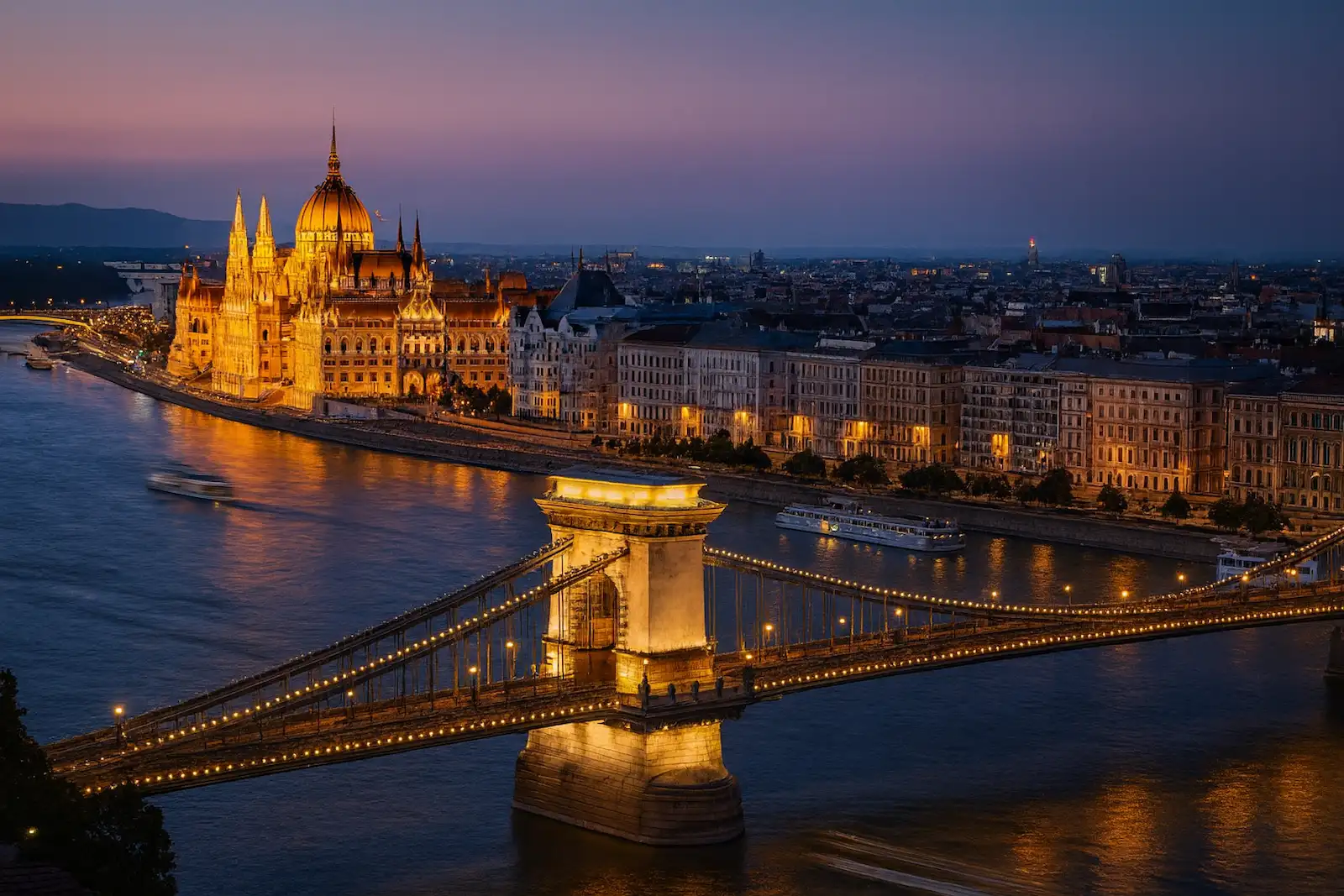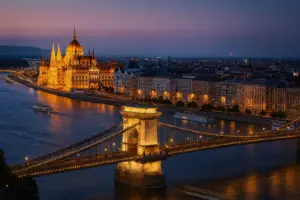Buda Castle
We begin our tour of Budapest at one of its most iconic places: Buda Castle. This imposing complex, perched atop the hill of the same name, dominates the city’s skyline and offers panoramic views that will take your breath away.

Buda Castle is not just a single building but an entire citadel that houses several points of interest:
- The Royal Palace: Now home to the Hungarian National Gallery and the Budapest History Museum, this majestic building has witnessed centuries of Hungarian history.
- Matthias Church: With its distinctive multicolored tile roof, this Gothic church is one of Budapest’s most recognizable landmarks.
- Fisherman’s Bastion: This fairy-tale lookout, with its white towers and stone arches, offers some of the best views in the city.
To reach the castle complex, you can take the Budapest Funicular—an experience in itself that will save you the uphill walk.
The history of Buda Castle is as rich as it is fascinating. Originally built in the 13th century, it has been destroyed and rebuilt several times over the centuries. During the Turkish occupation in the 16th century, it was converted into a mosque. Later, under Habsburg rule, it was transformed into a Baroque palace. It suffered severe damage during World War II and its restoration was not completed until the 1980s. Today, the castle stands as a living testament to Hungary’s resilience and a symbol of its rich history.
Budapest Parliament
Crossing the Danube from Buda Castle, you’ll find another indisputable symbol of the city: the Budapest Parliament. This colossal Neo-Gothic building is one of the largest in Europe and, without a doubt, one of the most impressive.

At 268 meters long and 96 meters tall, the Parliament dominates the Pest bank of the Danube. Its façade, adorned with 88 statues of Hungarian rulers, is a spectacle in itself. But the interior is just as impressive:
- The Grand Staircase: As soon as you enter, you’ll be greeted by this majestic staircase decorated with frescoes and statues.
- The Dome Hall: Here you can see the Hungarian Crown Jewels, including the famous Holy Crown of Saint Stephen.
- The Assembly Hall: The heart of Hungary’s legislative power, remarkable for both its décor and its history.
Chain Bridge
Speaking of the Danube, we can’t fail to mention the Chain Bridge, the first permanent bridge to unite the cities of Buda and Pest. Inaugurated in 1849, this suspension bridge is not only a marvel of the engineering of its time but also a symbol of the city’s unification.

Walking across the Chain Bridge is a must in Budapest. From here you can enjoy sweeping views of both Buda and Pest, with the Parliament and Buda Castle as a stunning backdrop.
St. Stephen’s Basilica
Heading into the heart of Pest, we come to St. Stephen’s Basilica, the most important church in Hungary and one of the tallest buildings in the city. This imposing Neoclassical basilica, dedicated to Hungary’s first king, is a must-see on any visit to Budapest.

Construction began in 1851, but due to various setbacks—including the collapse of the dome during a storm—it wasn’t completed until 1905. A surprising fact is that the basilica houses Hungary’s most treasured relic: the Holy Right Hand, supposedly the mummified right hand of King Saint Stephen.
Every August 20, during the national feast of Saint Stephen, this relic is carried in procession through the streets of Budapest. In addition, music lovers can enjoy regular organ concerts here, taking advantage of the building’s excellent acoustics and its magnificent 6,500-pipe organ.
Budapest Thermal Baths
We can’t talk about Budapest without mentioning its famous thermal baths. The city isn’t called the “City of Spas” for nothing. With more than 100 natural thermal springs, Budapest offers a unique bathing experience that blends relaxation, history, and architecture.

The spa culture in Budapest dates back to Roman times, but it was the Ottoman Turks who truly developed it in the 16th century. The Széchenyi Baths, inaugurated in 1913, are the largest in Europe and a true symbol of the city. A curious sight here is locals playing chess in the water—a unique Budapest tradition. The water at Széchenyi, rich in calcium, magnesium, and bicarbonate, is believed to have healing properties for joint and muscle issues. For an authentic experience, visit the baths early in the morning and watch as the city’s older residents go through their daily aquatic exercises.
The Great Synagogue of Budapest
The Great Synagogue of Budapest, also known as the Dohány Street Synagogue, is the largest synagogue in Europe and the second largest in the world. This impressive Moorish Revival building is much more than a place of worship; it is a symbol of the resilience and perseverance of Budapest’s Jewish community.

Fascinatingly, the Great Synagogue was designed by a Christian architect, Ludwig Förster, and its interior recalls that of a Catholic church. During World War II, it served as a base for German radio and even as a stable. Today, it houses the Jewish Museum of Budapest and a moving monument: the Tree of Life, a metal weeping willow sculpture bearing the names of Holocaust victims on its leaves.
Central Market Hall
To immerse yourself in Hungary’s culinary culture, there’s no better place than the Central Market Hall. This covered market—the largest and oldest in the city—is a paradise for food lovers and a perfect spot to buy authentic souvenirs.

Andrássy Avenue
Andrássy Avenue is to Budapest what the Champs-Élysées are to Paris. This elegant boulevard, a UNESCO World Heritage Site, connects Heroes’ Square with the city center and is lined with some of Budapest’s most impressive buildings.

Built between 1872 and 1885, Andrássy Avenue was part of the plan to transform Budapest into a modern metropolis. Along its 2.5 km, you’ll find the Hungarian State Opera, the House of Terror (a museum commemorating the fascist and communist regimes), and numerous embassies. Beneath the avenue runs Metro Line 1, the first metro line on the European continent, adding yet another layer of history to this iconic street.
Heroes’ Square
At the end of Andrássy Avenue lies Heroes’ Square, one of Budapest’s most emblematic public spaces. This majestic square pays tribute to the most important leaders and figures in Hungary’s history.

The Millennium Monument, the focal point of the square, was built in 1896 to commemorate the 1,000th anniversary of the Magyars’ arrival in the Carpathian Basin. The statues depict the seven tribal chieftains who led the Hungarians to these lands, as well as other historical leaders. Curiously, some statues were replaced after World War II to remove figures of the Habsburg dynasty.
City Park
Just behind Heroes’ Square stretches City Park (Városliget), Budapest’s green lung. This expansive park offers a break from the bustle of the city and is home to several interesting attractions:

City Park has a fascinating history. It was the site of the 1896 Millennium Exhibition celebrating 1,000 years of Hungary. Vajdahunyad Castle, originally built as a temporary structure for the exhibition, became so popular that it was reconstructed with permanent materials. In winter, the park’s lake turns into the largest outdoor ice rink in Europe, a tradition dating back to 1870.
Margaret Island
In the middle of the Danube, between Buda and Pest, lies Margaret Island, a 2.5-kilometer-long urban park that offers a peaceful retreat from the city’s hustle and bustle. It’s the perfect place for a picnic, a relaxing stroll, or a workout.

The island owes its name to Princess Margaret, daughter of King Béla IV, who lived here in a Dominican convent in the 13th century. Among its most curious attractions is a musical fountain that “dances” to the rhythm of classical music. The island also features the ruins of a 13th-century Franciscan monastery and a small wildlife area. On Sunday mornings, many locals head to the island to take part in free outdoor yoga classes.
Gellért Hill
No list of things to see in Budapest would be complete without Gellért Hill. This 235-meter rise offers some of the best panoramic views of the city. At its summit you’ll find:

The hill is named after Saint Gerard, a missionary who, according to legend, was thrown from here in a barrel lined with nails by pagans in the year 1046. The Citadel at the top was built by the Habsburgs after the 1848 revolution, supposedly to keep the city under control. Today, beyond the stunning views, visitors can explore World War II bunkers that have recently been opened to the public.
Jewish Quarter: history, culture, and nightlife
Budapest’s Jewish Quarter, also known as District VII or Erzsébetváros, is one of the city’s most fascinating neighborhoods. Once the Jewish ghetto during World War II, today it’s a vibrant hub of culture, gastronomy, and nightlife.

The Jewish Quarter is famous for its “ruin bars,” unique establishments set up in abandoned buildings that were once destined for demolition. The most famous, Szimpla Kert, pioneered this concept and has been named one of the best bars in the world. Beyond its nightlife, the neighborhood is home to vintage shops, trendy cafés, and some of the best street art in Budapest. Don’t miss the Wall of the Righteous, a mural honoring those who helped save Jewish lives during the Holocaust.
The Budapest Metro: a trip through time
The Budapest Metro is not just a means of transportation—it’s an attraction in its own right. Line 1, also known as the “Little Metro,” is the third-oldest metro line in the world and the first in continental Europe.

Inaugurated in 1896 as part of Hungary’s Millennium celebrations, Metro Line 1 is a gem of Victorian engineering. The original stations retain their 19th-century charm, with original tiles and period signage. Interestingly, the cars on this line are smaller than those on modern lines because of its shallow tunnel. In 2002, the line was declared a UNESCO World Heritage Site—the second metro system in the world to receive this honor, after London.
Practical tips for your visit to Budapest
To help you make the most of your visit to Budapest, here are some additional tips:
- City map: There’s nothing like downloading the best map of Budapest to get your bearings from the start and locate all the points of interest. It will also be useful for finding the area to stay in so you have easy access to the places you want to visit.
- Public transportation: Budapest has an excellent public transport system. Consider buying a multi-day pass to save money if you plan to move around the city a lot.
- Budapest Card: If you plan to visit many attractions, consider buying the Budapest Card. It offers free entry to various museums and attractions, as well as unlimited use of public transport.
- Danube cruises: A cruise on the Danube is an excellent way to see the city—especially at night when the buildings are illuminated.
- High vs. low season: Budapest can be very crowded in summer. If you prefer to avoid the crowds, consider visiting in spring or autumn.
- Language: Although Hungarian is the official language, many people in the tourism sector speak English. Even so, learning a few basic Hungarian phrases will be appreciated by locals.
- Tipping: In restaurants and cafés, it’s customary to leave a 10–15% tip if you’re satisfied with the service.
Budapest is a city that captivates at first sight and keeps secrets that only reveal themselves to those who take the time to explore it in depth. From its majestic historic buildings to its most bohemian corners, from its relaxing thermal baths to its vibrant nightlife, the Hungarian capital has something to offer every kind of traveler.
Whether you come for a weekend or a full week, Budapest will leave you wanting more. So grab your camera, put on your most comfortable shoes, and get ready to fall in love with one of the most beautiful and fascinating cities in Europe. Enjoy your visit to Budapest!
Best Free Tours in Budapest
If this is your first visit to Budapest, we highly recommend this tour, because this is a perfect introduction to…
Welcome to Budapest! Finally, you are here! If you would like to discover the city like a local, join m…
Did you know that most of the Jews deported to Auschwitz were Hungarian? Discover wit…
THE OFFICIAL AND THE BEST TOUR IN BUDA CASTLE FEEL THE CITY Our tour…
Explore Budapest through its alternative cultures on a 2 hour small-group walking tour of the sights and hist…
Our Buda tour is a journey through kings, legends, myths and a lot of medieval history. Buda Cast…
Let’s discover BOTH sides of the city — Buda AND Pest — together! 🥳 We’ll s…


